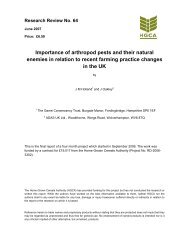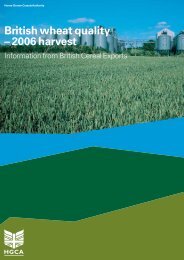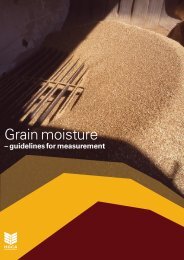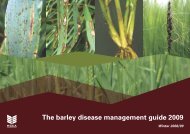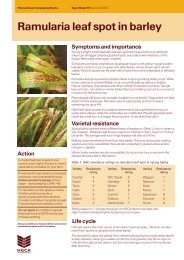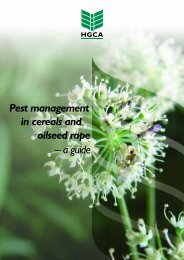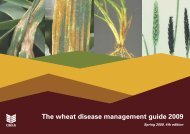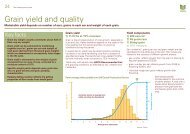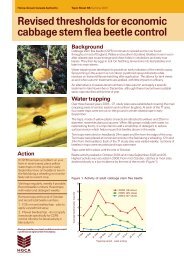Integrated control of wheat blossom midge - HGCA
Integrated control of wheat blossom midge - HGCA
Integrated control of wheat blossom midge - HGCA
You also want an ePaper? Increase the reach of your titles
YUMPU automatically turns print PDFs into web optimized ePapers that Google loves.
Marker AnalysisA molecular genetic marker has been reported by a Group in Winnipeg, Canada, as being diagnostic for amajor resistance gene, Sm1, in Canadian varieties (Thomas et al. 2004). To evaluate whether the ElsomsSeeds resistant varieties Welford and Charton carry this gene, and whether this molecular test is diagnosticfor resistance in European <strong>wheat</strong>s, molecular marker analysis was carried out by PCR using primers suppliedby the Canadian Group (data and methods provided in confidence).Results1. VarietiesLevels <strong>of</strong> infestation increased significantly over the three years <strong>of</strong> trials, being lowest in 2002 and greatestin 2004. Nevertheless, in all years, there were significant differences between the varieties and the relativerankings were maintained as infestation levels increased. In 2002 and 2003 there was a clear trend for earlierflowering, photoperiod insensitive varieties, such as Bezostaya, Poros and Soissons to escape infestation.However, in addition, there were clear genetical differences in infestation levels, and hence geneticresistance/tolerance between the varieties independent <strong>of</strong> flowering time. Most noticeable were thenegligible levels on Welford and Carlton, varieties known to carry major resistance genes.An evaluation <strong>of</strong> exotic, old varieties and landraces, such as Squarehead Masters, Chinese Spring, Atlas 66,and Triticum macha did not indicate sources <strong>of</strong> resistance as good as currently know resistance sourcesalready in cultivation. Perhaps it will require a screen <strong>of</strong> a much larger number <strong>of</strong> varieties to find newsources. However, it is clear that there are promising sources <strong>of</strong> resistance in addition to those in Welfordand Charlton, in varieties such as Herward and Spark, if the genes involved can be identified by geneticanalysis and manipulated by plant breeders.2. Chromosome Substitution linesFigure 2 shows the levels <strong>of</strong> infestation in the substitution lines over the three years <strong>of</strong> trial. Levels <strong>of</strong>infestation increased significantly over the three years <strong>of</strong> trials, being lowest in 2002 and greatest in 2004.As levels <strong>of</strong> infestation increased, differences between lines also decreased. In both years <strong>of</strong> joint testing,Bezostaya was infested significantly less than Cappelle-Desprez, but also had a significantly earlierflowering time, so this is probably due to escape, rather than resistance/tolerance per se.37



